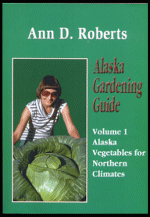 |
 |
Guide, Vol 1 ____________________ |
ISBN # 1-888125-54-3
- $29.95, second printing |
Sowing Success in Southcentral Alaska Part 3 of 3
This is part three of a three part series on gardening in Alaska, and more specifically, Southcentral Alaska. It covers variety selection and how photoperiods in the far north affect plant growth and bloom time. For a more comprehensive treatment of the subjects mentioned, please see Alaska Gardening Guide, Vol. 1.
©2005,Ann D. Roberts
Select for Success
Perhaps the only thing more important in Alaska than soil warming is variety selection. No matter how warm your soil, your garden will be a failure if your lettuce bolts, sending up a seed stalk instead of producing a head, your squash plants finally set fruit the week before the first frost, and your root crops never get around to producing. These problems are often the result of planting poorly adapted varieties.
Unfortunately, many seed-rack varieties at your local supermarket simply won’t do well in Alaska, even though the packet may read “Seed especially developed for your area." Chances are they’re the same varieties offered for sale in other northern states.
Until his retirement, Dr. Curtis H. Dearborn tested varieties for Southcentral. More recently, Dr. Don Carling has been carrying out potato trials. In Southeast, varieties were tested by local gardeners directed by Walt McPherson. Recently, Bob Gorman has been conducting limited trials in raised beds in Sitka. These are only a few who, over the years, have engaged in variety testing for Alaska.
The Cooperative Extension Service (CES), cooperating with the US Department of Agriculture, publishes the latest findings of the University's Agricultural Experiment Station scientists in three lists covering major state growing areas: Interior, Southcentral, and Southeast. The Southcentral list, obtainable free from any local Cooperative Extension Service office, now includes notes on maturity, yield, and growing tips.
Photoperiods
The problem with poorly adapted varieties is often not cold soil, but photoperiods. Photoperiodicity is the striking effect of day length on growth and reproduction in plants. While many plants aren’t particularly fussy in their requirements for a daily light-dark cycle (these are called day-neutrals), some very important ones are definitely long-day plants.
Still others are short-day plants, and it is these that present serious problems in far northern gardens exposed to constant daylight for months during the summer. Much of Alaska never really gets dark from early May to early August. Even at the southern tip of Southeastern Alaska, summer nights are still very much shorter than northern states like Washington and Maine.
Daylight itself is not the problem; it’s actually the length of the night that counts. A short-day plant is really a long-night plant. Plants carry out some very important chemical reactions at night; if they don’t have enough uninterrupted darkness to complete these, their whole life cycle may be upset.
The most noticeable effect is disruption of the flowering process. A street light outside the window will keep a poinsettia (which requires at least 12 hours of night) from blooming. Commercial growers routinely “force" short-day (long-night) autumn bloomers by darkening their greenhouses for part of each summer day.
Most varieties of squash and cucumbers produce only male flowers during early summer. Only when nights lengthen in the fall are female flowers also formed, often too late to produce mature fruit.
A few apparently short-day vegetables are eggplant, butternut squash, and true spinach. Most members of some other species (like beets and lettuce) are adversely affected by long days, but satisfactorily adapted varieties have been developed. Consult the variety lists Alaskan researchers have provided.
A Successful Harvest
There are wonderfully productive gardens in Southcentral, from north of Wasilla to south of Homer. By concentrating on soil warming, and by choosing adapted varieties of cool weather crops, you, too, can harvest success, sowing in Southcentral or on the Kenai Peninsula.
Ann D Roberts is the author of Alaska Gardening Guide Vol 1, covering cold weather gardening in Alaska, with specific growing tips for vegetables. The book, written and published in Alaska in 2000, is already the “definitive and indispensable reference guide to every Alaskan gardener.” Readers can check out its table of contents at http://AlaskaGardeningGuide.com. Ann is presently working on Vol 2, covering perennials and lawns. This article may be freely reprinted only if done so in its entirety, including this final paragraph.
Copyright 2002-2011, Aurora Webmasters Last updated January 24, 2012 Contact the Author, Ann D. Roberts. a member of the Garden Writers Association
by e-mailing: author*@*alaskagardeningguide.com (delete every *)